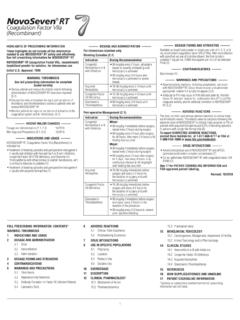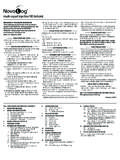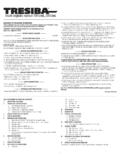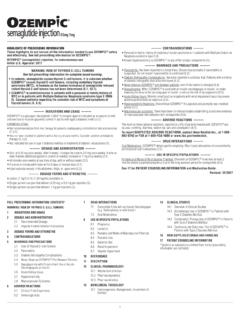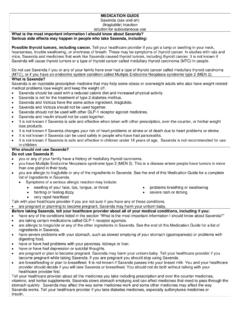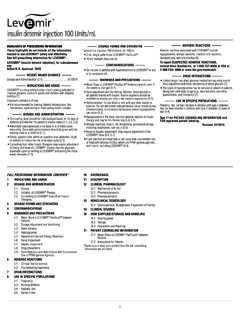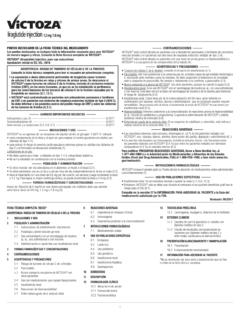Transcription of HIGHLIGHTS OF PRESCRIBING INFORMATION ...
1 1 CONTRAINDICATIONS Personal or family history of medullary thyroid carcinoma or in patients with Multiple Endocrine Neoplasia syndrome type 2 (4). Known hypersensitivity to ozempic or any of the product components (4). WARNINGS AND PRECAUTIONS Pancreatitis: Has been reported in clinical trials. Discontinue promptly if pancreatitis is suspected. Do not restart if pancreatitis is confirmed ( ). Diabetic Retinopathy Complications: Has been reported in a clinical trial. Patients with a history of diabetic retinopathy should be monitored ( ). Never share an ozempic pen between patients, even if the needle is changed ( ). Hypoglycemia: When ozempic is used with an insulin secretagogue or insulin, consider lowering the dose of the secretagogue or insulin to reduce the risk of hypoglycemia ( ).
2 Acute Kidney Injury: Monitor renal function in patients with renal impairment reporting severe adverse gastrointestinal reactions ( ). Hypersensitivity Reactions: Discontinue ozempic if suspected and promptly seek medical advice ( ). Macrovascular outcomes: There have been no clinical studies establishing conclusive evidence of macrovascular risk reduction with semaglutide ( ). ADVERSE REACTIONS The most common adverse reactions, reported in 5% of patients treated with ozempic are: nausea, vomiting, diarrhea, abdominal pain and constipation ( ).To report SUSPECTED ADVERSE REACTIONS, contact Novo Nordisk Inc., at 1-888-693-6742 or FDA at 1-800-FDA-1088 or DRUG INTERACTIONS Oral Medications: ozempic delays gastric emptying.
3 May impact absorption of concomitantly administered oral medications ( ). USE IN SPECIFIC POPULATIONS Females and Males of Reproductive Potential: Discontinue ozempic in women at least 2 months before a planned pregnancy due to the long washout period for semaglutide ( ).See 17 for PATIENT COUNSELING INFORMATION and Medication Guide. Revised: 12/2017 FULL PRESCRIBING INFORMATION : CONTENTS*WARNING: RISK OF THYROID C CELL TUMORS1 INDICATIONS AND USAGE2 DOSAGE AND ADMINISTRATION Recommended Dosage Important Administration Instructions3 DOSAGE FORMS AND STRENGTHS4 CONTRAINDICATIONS5 WARNINGS AND PRECAUTIONS Risk of Thyroid C-Cell Tumors Pancreatitis Diabetic Retinopathy Complications Never Share an ozempic Pen Between Patients Hypoglycemia with Concomitant Use of Insulin Secretagogues or Insulin Acute Kidney Injury Hypersensitivity Macrovascular Outcomes6 ADVERSE REACTIONS Clinical Trials Experience Immunogenicity7 DRUG INTERACTIONS Concomitant Use with an Insulin Secretagogue ( Sulfonylurea)
4 Or with Insulin Oral Medications8 USE IN SPECIFIC POPULATIONS Pregnancy Lactation Females and Males of Reproductive Potential Pediatric Use Geriatric Use Renal Impairment Hepatic Impairment10 OVERDOSAGE11 DESCRIPTION12 CLINICAL PHARMACOLOGY Mechanism of Action Pharmacodynamics Pharmacokinetics13 NONCLINICAL TOXICOLOGY Carcinogenesis, Mutagenesis, Impairment of Fertility14 CLINICAL STUDIES Overview of Clinical Studies Monotherapy Use of ozempic in Patients with Type 2 Diabetes Mellitus Combination Therapy Use of ozempic in Patients with Type 2 Diabetes Mellitus Cardiovascular Outcomes Trial of ozempic in Patients with Type 2 Diabetes Mellitus16 HOW SUPPLIED/STORAGE AND HANDLING17 PATIENT COUNSELING INFORMATION *Sections or subsections omitted from the full PRESCRIBING INFORMATION are not OF PRESCRIBING INFORMATIONT hese HIGHLIGHTS do not include all the INFORMATION needed to use ozempic safely and effectively.
5 See full PRESCRIBING INFORMATION for ozempic . ozempic (semaglutide) injection, for subcutaneous use Initial Approval: 2017 WARNING: RISK OF THYROID C CELL TUMORSSee full PRESCRIBING INFORMATION for complete boxed warning. In rodents, semaglutide causes thyroid C-cell tumors. It is unknown whether ozempic causes thyroid C-cell tumors, including medullary thyroid carcinoma (MTC), in humans as the human relevance of semaglutide-induced rodent thyroid C-cell tumors has not been determined ( , ). ozempic is contraindicated in patients with a personal or family history of MTC or in patients with Multiple Endocrine Neoplasia syndrome type 2 (MEN 2). Counsel patients regarding the potential risk of MTC and symptoms of thyroid tumors (4, ).
6 INDICATIONS AND USAGE ozempic is a glucagon-like peptide 1 (GLP-1) receptor agonist indicated as an adjunct to diet and exercise to improve glycemic control in adults with type 2 diabetes mellitus (1).Limitations of Use: Not recommended as first-line therapy for patients inadequately controlled on diet and exercise (1, ) . Has not been studied in patients with a history of pancreatitis. Consider another antidiabetic therapy (1, ). Not indicated for use in type 1 diabetes mellitus or treatment of diabetic ketoacidosis (1). DOSAGE AND ADMINISTRATION Start at mg once weekly. After 4 weeks, increase the dose to mg once weekly. If after at least 4 weeks additional glycemic control is needed, increase to 1 mg once weekly ( ).
7 Administer once weekly at any time of day, with or without meals ( ). If a dose is missed administer within 5 days of missed dose ( ). Inject subcutaneously in the abdomen, thigh, or upper arm ( ). DOSAGE FORMS AND STRENGTHS Injection: 2 mL ( mg/mL) available in: Single-patient-use pen that delivers mg or mg per injection (3). Single-patient-use pen that delivers 1 mg per injection (3). ozempic (semaglutide) injection, for subcutaneous use2 FULL PRESCRIBING INFORMATIONWARNING: RISK OF THYROID C CELL TUMORS In rodents, semaglutide causes dose-dependent and treatment-duration-dependent thyroid C-cell tumors at clinically relevant exposures. It is unknown whether ozempic causes thyroid C-cell tumors, including medullary thyroid carcinoma (MTC), in humans as human relevance of semaglutide-induced rodent thyroid C-cell tumors has not been determined [see Warnings and Precautions ( ) and Nonclinical Toxicology ( )].
8 ozempic is contraindicated in patients with a personal or family history of MTC or in patients with Multiple Endocrine Neoplasia syndrome type 2 (MEN 2) [see Contraindications (4)]. Counsel patients regarding the potential risk for MTC with the use of ozempic and inform them of symptoms of thyroid tumors ( a mass in the neck, dysphagia, dyspnea, persistent hoarseness). Routine monitoring of serum calcitonin or using thyroid ultrasound is of uncertain value for early detection of MTC in patients treated with ozempic [see Contraindica-tions (4) and Warnings and Precautions ( )].1 INDICATIONS AND USAGEOZEMPIC is indicated as an adjunct to diet and exercise to improve glycemic control in adults with type 2 diabetes mellitus [see Clinical Studies ( )].
9 Limitations of Use ozempic is not recommended as a first-line therapy for patients who have inadequate glycemic control on diet and exercise because of the uncertain relevance of rodent C-cell tumor findings to humans [see Warnings and Precautions ( )]. ozempic has not been studied in patients with a history of pancreatitis. Consider other anti-diabetic therapies in patients with a history of pancreatitis [see Warnings and Precautions ( )]. ozempic is not a substitute for insulin. ozempic is not indicated for use in patients with type 1 diabetes mellitus or for the treatment of patients with diabetic ketoacidosis, as it would not be effective in these DOSAGE AND Recommended Dosage Start ozempic with a mg subcutaneous injection once weekly for 4 weeks.
10 The mg dose is intended for treatment initiation and is not effective for glycemic control. After 4 weeks on the mg dose, increase the dosage to mg once weekly. If additional glycemic control is needed after at least 4 weeks on the mg dose, the dosage may be increased to 1 mg once weekly. The maximum recommended dosage is 1 mg once weekly. Administer ozempic once weekly, on the same day each week, at any time of the day, with or without meals. The day of weekly administration can be changed if necessary as long as the time between two doses is at least 2 days (>48 hours). If a dose is missed, administer ozempic as soon as possible within 5 days after the missed dose. If more than 5 days have passed, skip the missed dose and administer the next dose on the regularly scheduled day.
